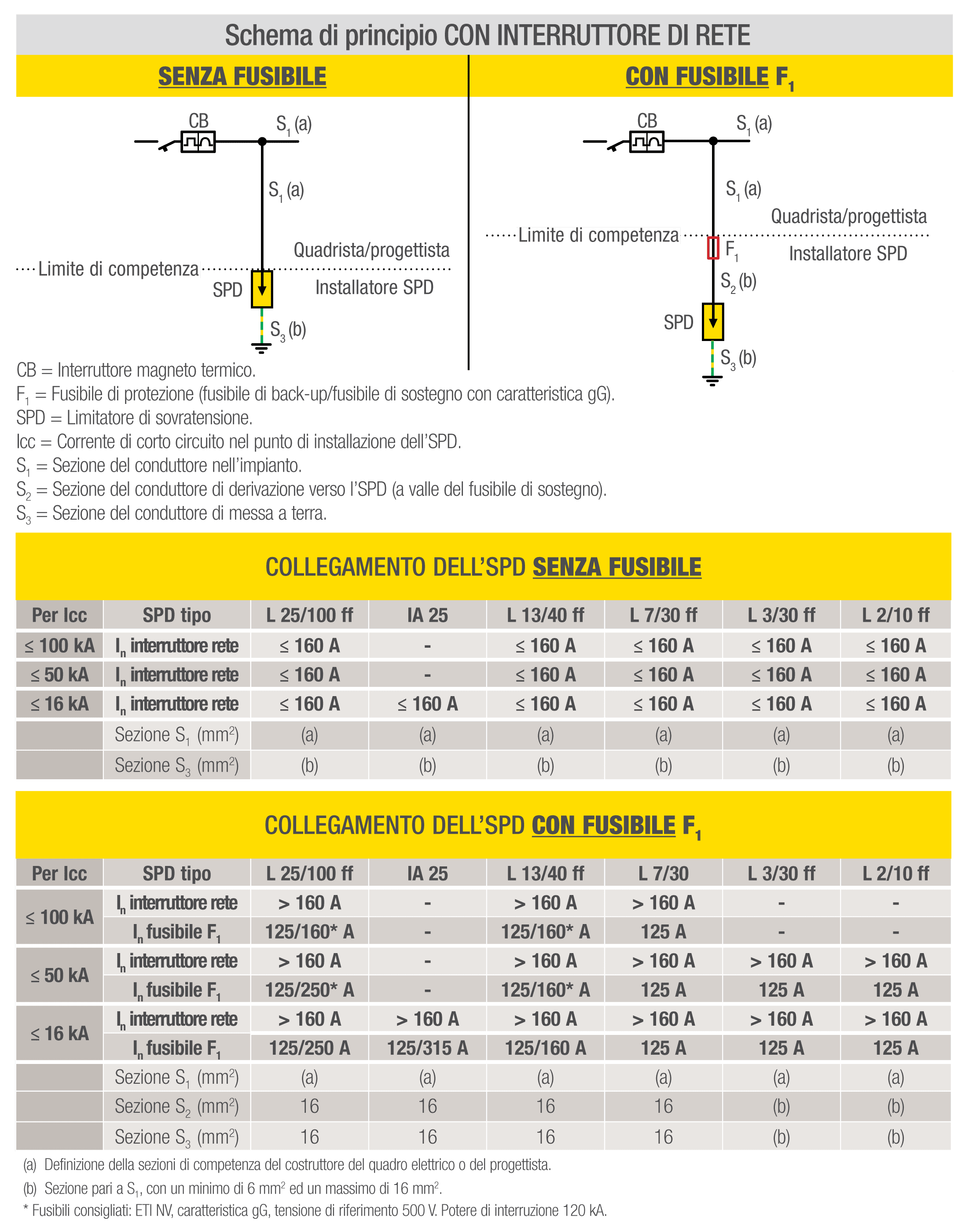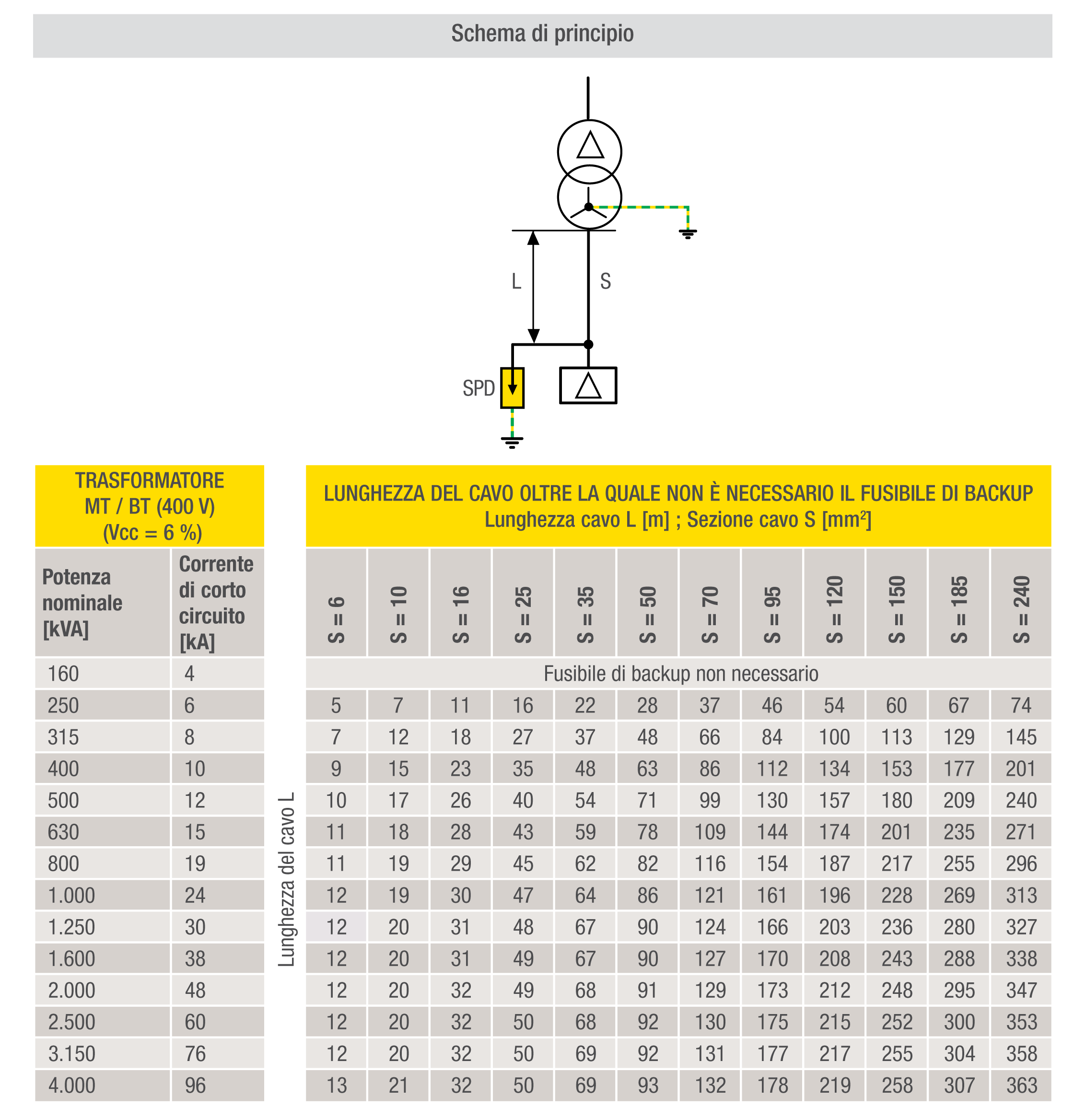SPD: INSTALLATION METHODS

Traduttore / Traduttore / 75% 10 B3
WHEN OVERCURRENT LIMITATION IS OR IS NOT NECESSARY
If the short circuit current at the ZOTUP installation point is superior to its interrupting power, it is it is necessary to provide a support/backup fuse in series with the arrester. The interaction between the overcurrent limiting measures present in the system and the SPD must be evaluated during the design and installation phase. The standards HD 60364-5-534 (2016-02), EN 64-8/4 443.2.2 Ed. 7 (2012-06) and CEI EN 62305 Ed. 2 series must be taken into consideration. Depending on the conductor section of the line S1 and of the line protection (thermic circuit breaker or fuse), is It is necessary to follow the instructions provided in the following tables.
The interaction between the overcurrent limiting measures present in the system and in series with the SPD must be evaluated during the design and installation phase. In this regard, the CEI 64-8 (2012) and CEI EN 62305 1-4 Standards must be taken into consideration.
The SPDs of the ZOTUP range have a certain short-circuit current interrupting capacity which occurs when the arrester reaches the end of its life due to overload. When the system short-circuit current is below this value, you can avoid installing the back-up/support overcurrent limitation in series with the SPD with all the resulting advantages. In order to simplify the evaluation of this opportunity The following table is proposed which allows you to quickly and prudently define the cable length above which the back-up/support fuse is not present. required. The cable length is function of the nominal power of the MV/LV transformer and of the cable section. By performing a precise calculation of the Icc, which takes into consideration the real sections of the conductors, the length of the cable which allows to avoid the installation of the back-up fuse up is smaller than that shown in the table (as it assumes, as a precaution, a constant cable section).
WHEN OVERCURRENT LIMITATION IS OR IS NOT NECESSARY
If the short circuit current at the ZOTUP installation point is superior to its interrupting power, it is it is necessary to provide a support/backup fuse in series with the arrester. The interaction between the overcurrent limiting measures present in the system and the SPD must be evaluated during the design and installation phase. The standards HD 60364-5-534 (2016-02), EN 64-8/4 443.2.2 Ed. 7 (2012-06) and CEI EN 62305 Ed. 2 series must be taken into consideration. Depending on the conductor section of the line S1 and of the line protection (thermic circuit breaker or fuse), is It is necessary to follow the instructions provided in the following tables.
The interaction between the overcurrent limiting measures present in the system and in series with the SPD must be evaluated during the design and installation phase. In this regard, the CEI 64-8 (2012) and CEI EN 62305 1-4 Standards must be taken into consideration.
The SPDs of the ZOTUP range have a certain short-circuit current interrupting capacity which occurs when the arrester reaches the end of its life due to overload. When the system short-circuit current is below this value, you can avoid installing the back-up/support overcurrent limitation in series with the SPD with all the resulting advantages. In order to simplify the evaluation of this opportunity The following table is proposed which allows you to quickly and prudently define the cable length above which the back-up/support fuse is not present. required. The cable length is function of the nominal power of the MV/LV transformer and of the cable section. By performing a precise calculation of the Icc, which takes into consideration the real sections of the conductors, the length of the cable which allows to avoid the installation of the back-up fuse up is smaller than that shown in the table (as it assumes, as a precaution, a constant cable section).

 Deutsch
Deutsch
 Français
Français
 Italiano
Italiano